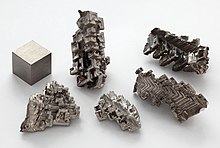
When Dmitry Mendeleev crafted his Periodic Table, he ordered all the elements by atomic weight and by their properties. In effect, the table has stayed the same, albeit with more elements, and they're sorted by atomic number instead (with exceptions). This leaves some curious arrangements:
Lead is a toxic metal, used by various societies in making water pipes and plumbing systems. Polonium was the first radioactive element to be discovered, and it can kill you too. Bismuth, meanwhile, is present in Pepto Bismol, a prescription medicine which can be used to treat acid reflux and heartburn. So far, so reasonable - bismuth appears to be a weird island of safety, when compared to its neighbours (and other nearby elements, like astatine and radon, are also quite harmful).
Not that bismuth is entirely safe, though. It is the least toxic out of all the heavy metals, yet ingesting large amounts can cause kidney damage and even poisoning, though this is often rare. This is because bismuth compounds are typically insoluble, and so are poorly absorbed by the body. So Pepto Bismol, whose main component is bismuth subsalicylate (C7H5BiO4), can be used to treat diarrhoea and nausea, yet shouldn't be taken in excessive doses.
Bismuth's health benefits are also evident in compounds having been used to treat syphilis and malaria, as well as in attacking the H. pylori bacteria which causes the growth of peptic ulcers. Bibrocathol is an antiseptic which can be used (to an extent) as a treatment for eye infections.

Other ways in which bismuth defies expectations of its neighbours are:
- It expands as it solidifies by about 3.3% - thus, it's denser as a liquid than as a solid, much like water. As such, bismuth was often used in typesetting, where an alloy would be poured into moulds of characters, and fill the entire mould as it solidified. Nowadays, typesetting is a dying breed, so isn't a primary use for bismuth.
- Bismuth is the most diamagnetic element - so thus repel magnets the best. It can even levitate. This is due to its size - as a heavy metal, all orbitals up to 6f are occupied, and its outermost electrons travel at such fast speeds, relativity comes into play. The 6s and 6p orbitals move closer to the nucleus, and this is responsible for its diamagnetism - otherwise, it should be paramagnetic, or have an unpermanent magnetic field.
- Bismuth can act as a superconductor due to this diamagnetism, unlike most other heavy metals around it, which could make it useful in quantum computing. That doesn't make it a good thermal conductor, however - mercury is the only weaker metal in this category.
- Despite its dull grey metal form, some bismuth crystals can be very colourful and unnatural looking. This is due to heavy oxidising which interacts with different wavelengths of light to produce this odd effect:

No surprise some claim these crystals have magical powers - good thing lead doesn't make these, or else many would die.
On the topic of lead, despite all these peculiar uses of bismuth, its main purpose is to replace the toxic and pervasive role that lead has had in human history. 20,000 tonnes are mined every year to be used in brass in water pipes and plumbing fixtures, as well as in solders, along with ceramic glazes and also in cosmetics. Regulations restricting the use of lead in manufacturing makes it all the more likely that bismuth will become more prominent.
However, this bismuth often has to be sourced from various different ores and then separated out, because it isn't found natively in the ground - historically, it has been a byproduct of the extraction of lead ores, or from minerals like bismite(Bi2O3).
Bismuth's only natural isotope, 209Bi, is weakly radioactive, though its half life is also estimated to be 2*1019 years, which is also longer than the lifespan of the universe. The obvious question is how scientists came to this conclusion, and the answer is extrapolation from the α decay of a small sample of 209Bi atoms. Initially 209Bi was thought to be the heaviest stable atom, but this was disproved in 2003 after experiments saw it undergo α decay into 205Tl (and the linked article also reveals that initial estimates of 209Bi's half-life were cautiously over-optimistic). There have been synthesised isotopes of bismuth, but their half-lives are far shorter, and unsurprisingly have no worthwhile uses in industry.
Another place where bismuth shines (probably not literally) is as a nuclear coolant. Along with lead, it has the lowest neutron absorption cross section (essentially, a neutron is unlikely to hit the nucleus) out of all the liquid metal coolants possible, which, along with its low melting point (271℃), makes bismuth (along with lead and tin) an effective element as part of an alloy in coolant.
As such, bismuth is arguably one of the most baffling elements. The last element before they get irradiating happens to be rather safe and also stunning, with various unconventional uses that are only likely to get more prevalent in the future.
That is just amazing!
ReplyDelete